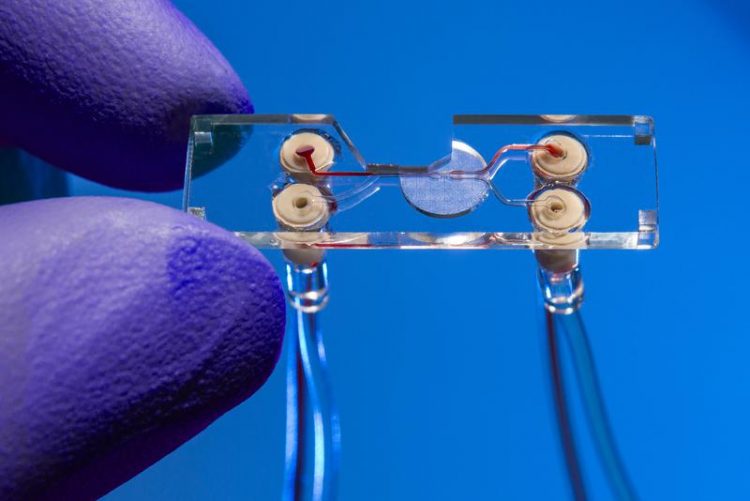Fast Personalized Therapeutic Choices Thanks to the Light-Based Sorting of Biomolecules and Cells

Image 1: Sorting chip for analyzing and isolating cells in a blood sample. © Fraunhofer ILT, Aachen / Volker Lannert.
The “AnaLighter” is a compact diagnostic device for sorting cells and biomolecules. Its technological core is based on an optically switchable microfluidic chip whose optical sensors and switches are connected to the chip via optical fibers. The “Microchip Based Fluorescence Activated Cell Sorter”, μFACS, functions in the following way:
The biomolecules and cells to be analyzed by fluorescence are guided through a microfluidic channel and focused hydrodynamically on a cross-section of 10 μm at the site of the optical measurement. Laser light from an optical fiber stimulates the analyte in the microfluidic channel to fluoresce. Then, micro-optics focus the laser light emerging from the fiber into the microfluidic channel, collect the fluorescent light generated there and guide it through optical fibers to the photodetector.
This fiber-optic design allows a significant reduction in the installation space and makes the μFACS more rugged compared to the prior state-of-the-art. The “AnaLighter technology” is, therefore, ideally suited for automated diagnostic applications in 24/7 operation.
Furthermore, fiber splitter technology makes it possible to generate several optical excitation channels from a laser beam cost-effectively. The advantage of our μFACS, explains the head of the Group of Clinical Diagnostics at Fraunhofer ILT, Dr. Achim Lenenbach, “lies in its ability to offer patients customized solutions designed for a specific application”.
Multispectral Detection
Depending on the application, the Aachen experts can adapt the “AnaLighter technology” individually: Via standardized fiber interfaces, wavelengths can be exchanged and easily adapted to a special measuring task without additional adjustment effort. Multiple wavelengths can be superimposed in a fiber and used for multispectral measurements.
Currently, a system with 16 detection channels is available using 6 different excitation wavelengths. This means that 16 different species can be detected simultaneously. However, the number of detection channels is not a limitation in principle and can be expanded as required.
A special feature of “AnaLighter technology” is the opto-fluidic sorting function. It is based on the fact that the viscosity of the fluid is thermally influenced by infrared laser radiation. By heating the fluid before branching, the system deflects and separates the liquid stream along with the detected analyte before the branching.
In this way, biomolecules or cells can be sorted out and stored in sample containers on the fluidic chip for further investigation. Since the branches are arranged serially, the systems can solve complex sorting tasks for separating different species.
Multiplex Diagnostics: Detecting Many Disease Markers with One Analysis
The spectrally separated detection channels of the “AnaLighter” can simultaneously detect different marker molecules in the blood. In such multiplex diagnostics, these marker molecules from a blood sample are specifically bound by a mixture of microparticles, each particle species binding exactly one molecule species to be detected.
The detection of bound marker molecules is encoded by a characteristic fluorescence label and its signal measured by one of the 16 detection channels. Such multiplex diagnosis can detect up to 16 different disease markers with only one measurement run. In annual routine checks, a general practitioner can detect a large number of possible diseases early in the course of a single blood test in order to prevent widespread diseases, i.e. cardiovascular disease.
Detecting Tumors Early
In contrast to conventional FACS systems, the μFACS technology of the Fraunhofer ILT can also process water-in-oil emulsions in addition to aqueous solutions. A few micrometer-sized aqueous droplets are passed through the fluidic channel in an oily fluid as carrier medium.
The aqueous droplets can be used as closed reaction volumes for screening applications in chemistry or biotechnology. The sorting function also makes it possible to separate out the appropriate candidates from the others during screening, in order to dispose of the relevant gene sequences in e.g. genetically modified variants.
Fraunhofer ILT at the COMPAMED
From November 13 to 16, 2017, our scientists will present the “AnaLighter technology” at the joint IVAM stand, F34.4, in Hall 8a.
Contact
Dr. rer. nat. Achim Lenenbach
Manager of the Group Clinical Diagnostics and Microsurgical Systems
Phone +49 241 8906-124
achim.lenenbach@ilt.fraunhofer.de
http://www.ilt.fraunhofer.de/en
https://www.ilt.fraunhofer.de/en/fairs-and-events/fairs/compamed-2017.html
Media Contact
All latest news from the category: Life Sciences and Chemistry
Articles and reports from the Life Sciences and chemistry area deal with applied and basic research into modern biology, chemistry and human medicine.
Valuable information can be found on a range of life sciences fields including bacteriology, biochemistry, bionics, bioinformatics, biophysics, biotechnology, genetics, geobotany, human biology, marine biology, microbiology, molecular biology, cellular biology, zoology, bioinorganic chemistry, microchemistry and environmental chemistry.
Newest articles

Properties of new materials for microchips
… can now be measured well. Reseachers of Delft University of Technology demonstrated measuring performance properties of ultrathin silicon membranes. Making ever smaller and more powerful chips requires new ultrathin…

Floating solar’s potential
… to support sustainable development by addressing climate, water, and energy goals holistically. A new study published this week in Nature Energy raises the potential for floating solar photovoltaics (FPV)…

Skyrmions move at record speeds
… a step towards the computing of the future. An international research team led by scientists from the CNRS1 has discovered that the magnetic nanobubbles2 known as skyrmions can be…





















